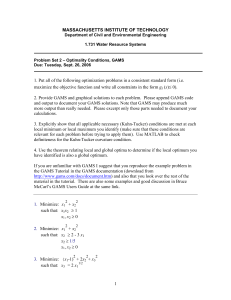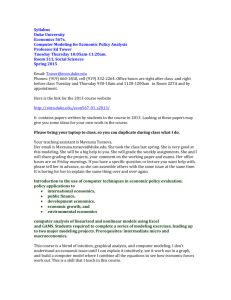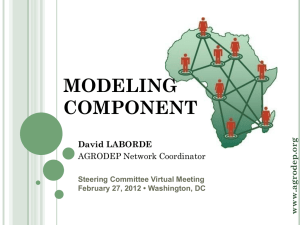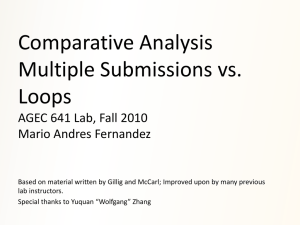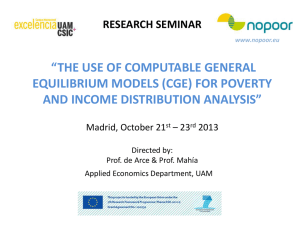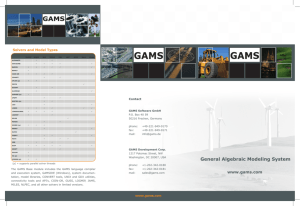Master « Economie de la mondialisation » 2nd Semester Course
advertisement
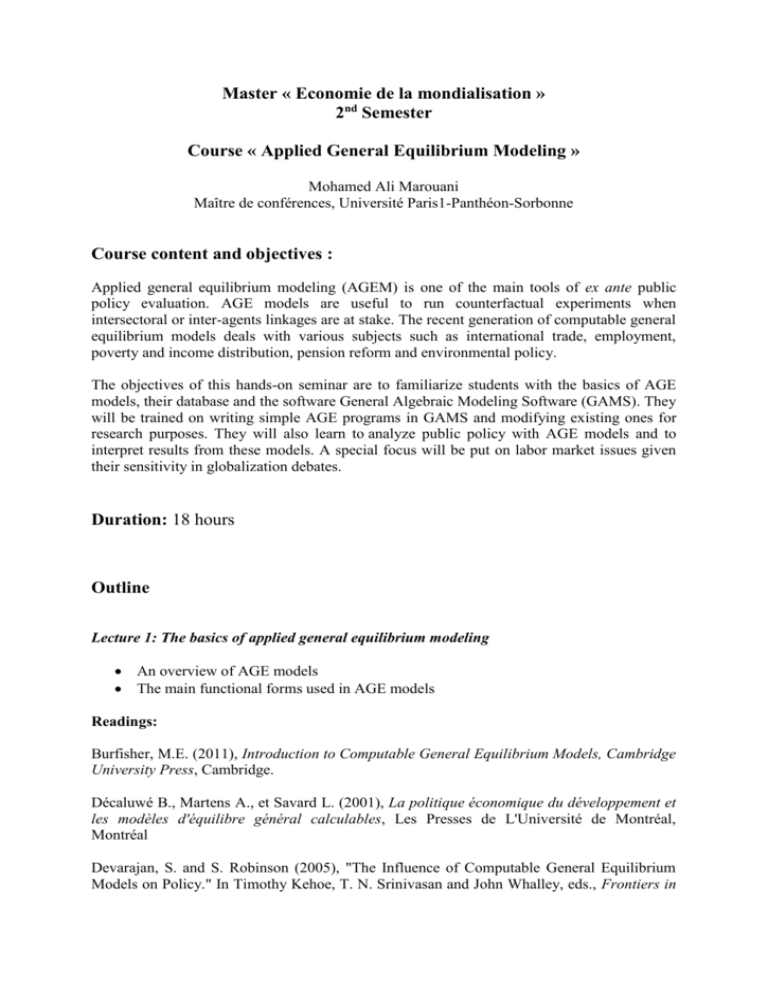
Master « Economie de la mondialisation » 2nd Semester Course « Applied General Equilibrium Modeling » Mohamed Ali Marouani Maître de conférences, Université Paris1-Panthéon-Sorbonne Course content and objectives : Applied general equilibrium modeling (AGEM) is one of the main tools of ex ante public policy evaluation. AGE models are useful to run counterfactual experiments when intersectoral or inter-agents linkages are at stake. The recent generation of computable general equilibrium models deals with various subjects such as international trade, employment, poverty and income distribution, pension reform and environmental policy. The objectives of this hands-on seminar are to familiarize students with the basics of AGE models, their database and the software General Algebraic Modeling Software (GAMS). They will be trained on writing simple AGE programs in GAMS and modifying existing ones for research purposes. They will also learn to analyze public policy with AGE models and to interpret results from these models. A special focus will be put on labor market issues given their sensitivity in globalization debates. Duration: 18 hours Outline Lecture 1: The basics of applied general equilibrium modeling An overview of AGE models The main functional forms used in AGE models Readings: Burfisher, M.E. (2011), Introduction to Computable General Equilibrium Models, Cambridge University Press, Cambridge. Décaluwé B., Martens A., et Savard L. (2001), La politique économique du développement et les modèles d'équilibre général calculables, Les Presses de L'Université de Montréal, Montréal Devarajan, S. and S. Robinson (2005), "The Influence of Computable General Equilibrium Models on Policy." In Timothy Kehoe, T. N. Srinivasan and John Whalley, eds., Frontiers in Applied General Equilibrium Modeling: Essays in Honor of Herbert Scarf. Cambridge: Cambridge University Press. Lecture 2: The database of AGE models An introduction to social accounting matrices (SAMs) Exercise: building a simple SAM Readings: Pradhan B.K. , M.R. Saluja, and S.K. Singh, (2006), Social Accounting Matrix For India Concepts Construction And Applications, Sage Publications India, New Delhi. Reinert, K. A. and D. W. Roland-Holst, (1997), Social Accounting Matrices, chapter four in Applied Methods for Trade Policy Analysis: A Handbook J.F. Francois and K.A. Reinert eds, Cambridge University Press, pp. 94-121. Robilliard, A.S. and S. Robinson, (2003), "Reconciling Household Surveys and National Accounts Data Using a Cross Entropy Estimation Method," Review of Income and Wealth, Wiley Blackwell, vol. 49(3), pages 395-406, 09. Lecture 3: An introduction to the GAMS software GAMS: the basics Exercise: Writing a simple AGE model in GAMS Readings: Löfgren, H., Harris, R.L. and Robinson, S., (2001), "A standard computable general equilibrium (CGE) model in GAMS," TMD discussion papers 75, International Food Policy Research Institute (IFPRI). Rosenthal, R.E. (2011) A User's Guide Tutorial, GAMS Development Corporation, Washington, DC, USA. (http://www.gams.com/dd/docs/bigdocs/GAMSUsersGuide.pdf) Lecture 4: A focus on labor markets’ modeling The production function and labor demand block Labor supply and migration Wage-setting mechanisms and unemployment Agénor, P.R, Izquierdo, A. and Jensen, H. T. (2007). Adjustment Policies, Poverty, and Unemployment: The IMMPA Framework. Malden: Blackwell Publishing Inc. Devarajan, S., H. Ghanem and K. Thierfelder (1997). "Economic Reform and Labor Unions: A General- Equilibrium Analysis Applied to Bangladesh and Indonesia." The World Bank Economic Review 11(1): 145-170. Marouani, M.A. and D. Robalino (2011) “Assessing Interactions among education, social insurance and labor market policies in Morocco”, Applied Economics, volume 44, Issue 24, pp. 3149-3167. Marouani, M.A. (2010), “More jobs for University Graduates: some policy Options for Tunisia”, Applied Economics Letters, 1466-4291, volume 17, Issue 10, p.p 933 – 937. Lecture 5: Extending the basic model in GAMS In this lecture, students develop an extension of the basic model built in lecture 3. The extensions could be related to the blocks developed in lecture 4, or could deal with other issues such as trade policy modeling (this depends on students’ personal interests). Francois, J and K. Reinert (eds.), (1997), Applied Methods for Trade Policy Analysis: A Handbook. Cambridge University Press (UK). Konan, D.E. And K.E. Maskus (2006), “Quantifying the impact of services liberalization in a developing country,” Journal of Development Economics, Vol. 81, No. 1, October, 142-162. Marouani, M.A. (2009), “Is the end of the MFA a threat?”, Review of Development Economics, 13(1), pp. 99–110. Lecture 6: Policy simulations and results’ interpretation The models developed in the previous session are used to simulate policies. The results are discussed with a focus on the main mechanisms behind the observed outcomes.
